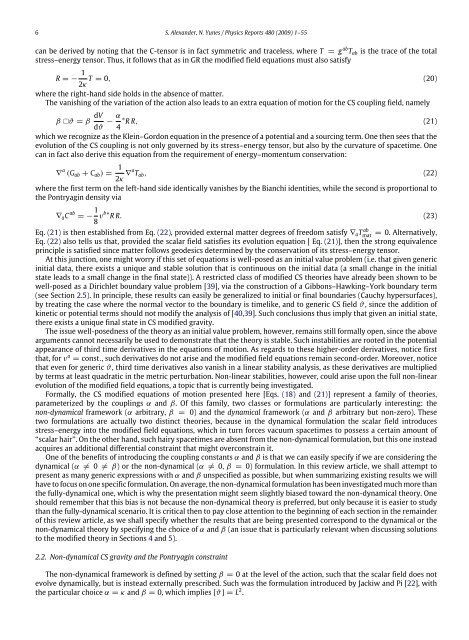Physics Reports ChernâSimons modified general relativity
Physics Reports ChernâSimons modified general relativity
Physics Reports ChernâSimons modified general relativity
Create successful ePaper yourself
Turn your PDF publications into a flip-book with our unique Google optimized e-Paper software.
6 S. Alexander, N. Yunes / <strong>Physics</strong> <strong>Reports</strong> 480 (2009) 1–55can be derived by noting that the C-tensor is in fact symmetric and traceless, where T = g ab T ab is the trace of the totalstress–energy tensor. Thus, it follows that as in GR the <strong>modified</strong> field equations must also satisfyR = − 1T = 0, (20)2κwhere the right-hand side holds in the absence of matter.The vanishing of the variation of the action also leads to an extra equation of motion for the CS coupling field, namelyβ □ϑ = β dVdϑ − α ∗ R R, (21)4which we recognize as the Klein–Gordon equation in the presence of a potential and a sourcing term. One then sees that theevolution of the CS coupling is not only governed by its stress–energy tensor, but also by the curvature of spacetime. Onecan in fact also derive this equation from the requirement of energy–momentum conservation:∇ a (G ab + C ab ) = 12κ ∇a T ab , (22)where the first term on the left-hand side identically vanishes by the Bianchi identities, while the second is proportional tothe Pontryagin density via∇ a C ab = − 1 8 vb∗ R R. (23)Eq. (21) is then established from Eq. (22), provided external matter degrees of freedom satisfy ∇ a T abmat= 0. Alternatively,Eq. (22) also tells us that, provided the scalar field satisfies its evolution equation [ Eq. (21)], then the strong equivalenceprinciple is satisfied since matter follows geodesics determined by the conservation of its stress–energy tensor.At this junction, one might worry if this set of equations is well-posed as an initial value problem (i.e. that given genericinitial data, there exists a unique and stable solution that is continuous on the initial data (a small change in the initialstate leads to a small change in the final state)). A restricted class of <strong>modified</strong> CS theories have already been shown to bewell-posed as a Dirichlet boundary value problem [39], via the construction of a Gibbons–Hawking–York boundary term(see Section 2.5). In principle, these results can easily be <strong>general</strong>ized to initial or final boundaries (Cauchy hypersurfaces),by treating the case where the normal vector to the boundary is timelike, and to generic CS field ϑ, since the addition ofkinetic or potential terms should not modify the analysis of [40,39]. Such conclusions thus imply that given an initial state,there exists a unique final state in CS <strong>modified</strong> gravity.The issue well-posedness of the theory as an initial value problem, however, remains still formally open, since the abovearguments cannot necessarily be used to demonstrate that the theory is stable. Such instabilities are rooted in the potentialappearance of third time derivatives in the equations of motion. As regards to these higher-order derivatives, notice firstthat, for v a = const., such derivatives do not arise and the <strong>modified</strong> field equations remain second-order. Moreover, noticethat even for generic ϑ, third time derivatives also vanish in a linear stability analysis, as these derivatives are multipliedby terms at least quadratic in the metric perturbation. Non-linear stabilities, however, could arise upon the full non-linearevolution of the <strong>modified</strong> field equations, a topic that is currently being investigated.Formally, the CS <strong>modified</strong> equations of motion presented here [Eqs. (18) and (21)] represent a family of theories,parameterized by the couplings α and β. Of this family, two classes or formulations are particularly interesting: thenon-dynamical framework (α arbitrary, β = 0) and the dynamical framework (α and β arbitrary but non-zero). Thesetwo formulations are actually two distinct theories, because in the dynamical formulation the scalar field introducesstress–energy into the <strong>modified</strong> field equations, which in turn forces vacuum spacetimes to possess a certain amount of‘‘scalar hair’’. On the other hand, such hairy spacetimes are absent from the non-dynamical formulation, but this one insteadacquires an additional differential constraint that might overconstrain it.One of the benefits of introducing the coupling constants α and β is that we can easily specify if we are considering thedynamical (α ≠ 0 ≠ β) or the non-dynamical (α ≠ 0, β = 0) formulation. In this review article, we shall attempt topresent as many generic expressions with α and β unspecified as possible, but when summarizing existing results we willhave to focus on one specific formulation. On average, the non-dynamical formulation has been investigated much more thanthe fully-dynamical one, which is why the presentation might seem slightly biased toward the non-dynamical theory. Oneshould remember that this bias is not because the non-dynamical theory is preferred, but only because it is easier to studythan the fully-dynamical scenario. It is critical then to pay close attention to the beginning of each section in the remainderof this review article, as we shall specify whether the results that are being presented correspond to the dynamical or thenon-dynamical theory by specifying the choice of α and β (an issue that is particularly relevant when discussing solutionsto the <strong>modified</strong> theory in Sections 4 and 5).2.2. Non-dynamical CS gravity and the Pontryagin constraintThe non-dynamical framework is defined by setting β = 0 at the level of the action, such that the scalar field does notevolve dynamically, but is instead externally prescribed. Such was the formulation introduced by Jackiw and Pi [22], withthe particular choice α = κ and β = 0, which implies [ϑ] = L 2 .



![arXiv:1001.0993v1 [hep-ph] 6 Jan 2010](https://img.yumpu.com/51282177/1/190x245/arxiv10010993v1-hep-ph-6-jan-2010.jpg?quality=85)


![arXiv:1008.3907v2 [astro-ph.CO] 1 Nov 2011](https://img.yumpu.com/48909562/1/190x245/arxiv10083907v2-astro-phco-1-nov-2011.jpg?quality=85)







![arXiv:1002.4928v1 [gr-qc] 26 Feb 2010](https://img.yumpu.com/41209516/1/190x245/arxiv10024928v1-gr-qc-26-feb-2010.jpg?quality=85)
![arXiv:1206.2653v1 [astro-ph.CO] 12 Jun 2012](https://img.yumpu.com/39510078/1/190x245/arxiv12062653v1-astro-phco-12-jun-2012.jpg?quality=85)
